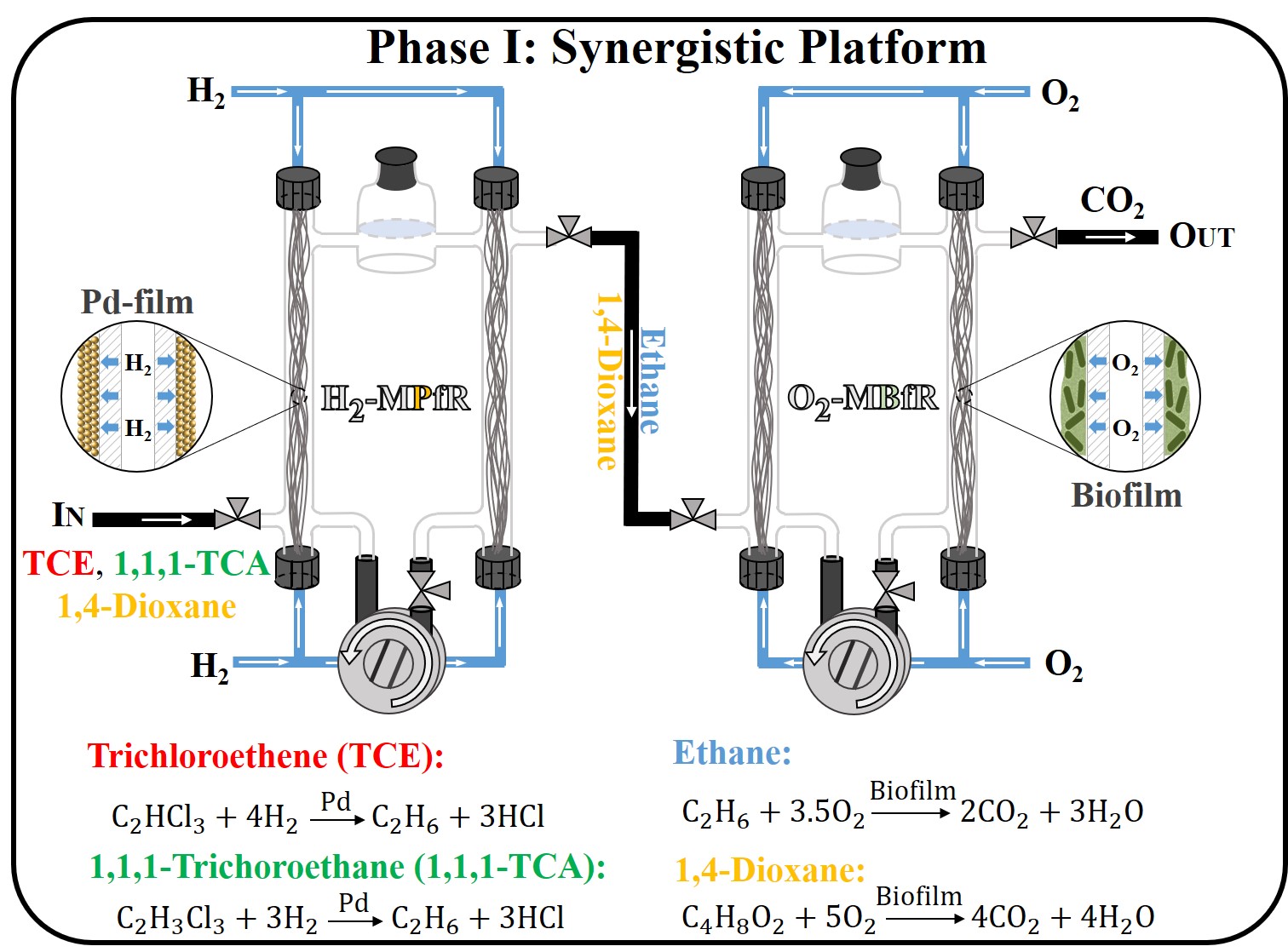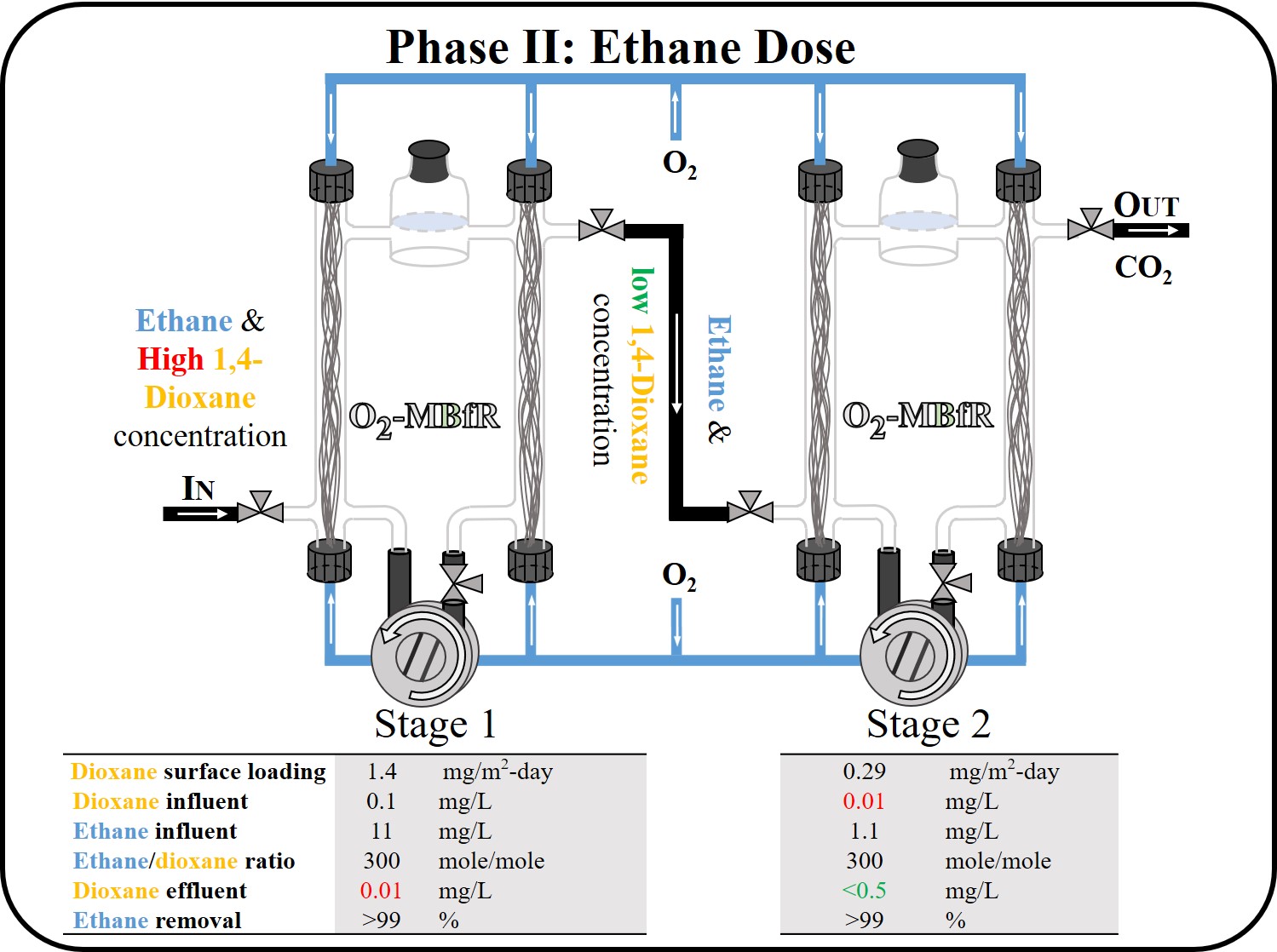PROJECT TITLE: Synergistic Reductive Dechlorination of 1,1,1-Trichloroethane and Trichloroethene and Aerobic Biodegradation of 1,4-Dioxane
Graphical Summary
Phase I Focus: Synergistic Platform (2017-2019)
 |
Phase II Focus: Ethane Dose (2019-2021)
 |
Project Overview
Phase I:
Groundwater co-contaminated with 1,4-dioxane and 1,1,1-trichloroethane (TCA) and/or trichloroethene (TCE) is common. We tested a synergistic platform featuring anaerobic TCE/TCA reduction in a H2-based reactor followed by aerobic 1,4-dioxane biodegradation in a O2-based membrane biofilm reactor (O2-MBfR). For the H2-based reduction stage, we evaluated the hydrogen-based Membrane Biofilm Reactor (MBfR) and a new hydrogen-based Membrane Palladium-film Reactor (MPfR). We conducted parallel modeling and experimental programs for the two MBfRs and an experimental program for the MPfR. Our evaluations proved that the rate and selectivity for reductive dichlorination of TCE/TCA to ethane was significantly higher with the MPfR than the MBfR. We configured the synergistic platform by linking the H2-based MPfR with a 1,4-dioxane oxidizing O2-MBfR in sequence. The ethane produced from reduction of TCE and TCA served as the primary electron donor for com-metabolic biodedgradation of 1,4-dioxane in the O2-MBfR. In summary, we demonstrated proof-of-concept for removing TCE, TCA, and 1,4-dioxane without accumulation of toxic intermediates in a synergistic platform featuring a H2-based MPfR for Pd-catalyzed TCE/TCA reduction followed by an O2-based MBfR for biological degradation of 1,4-dioxane plus products from TCE/TCA reduction. This research advanced understanding of the fundamental factors controlling Pd-catalyzed reductive dechlorination and the co-metabolic biodegradation of dioxane derivatives.
Phase II:
In Phase 2, which is on-going now, we are focusing on the O2-MBfR. Using bench-scale experiments and mathematical modeling, we are evaluating two fundamental aspects that have profound practical impacts for the performance of the O2-MBfR. The first fundamental issue concerns how much ethane must be supplied to the O2-MBfR in order to accumulate enough active biofilm to fully mineralize the 1,4-dioxane in the influent. As a primary substrate, the ethane must fulfill two roles. One, its oxidation must provide energy and electrons to support sufficient biofilm biomass to be able to biodegrade 1,4-dioxane. Two, its oxidation also must supply electrons to fuel the mono-oxygenation reactions that initiate biodegradation of 1,4-dioxane. We are systematically evaluating the concentration of ethane needed to carry out both tasks. We will compare the need for ethane with the amount of ethane provided by reductions of TCE and TCA in the H2-MPfR. The second fundamental issue concerns the kinetics of 1,4-dioxane biodegradation when the ethane supply is adequate. We are exploring systematically how the concentrations of 1,4-dioxane, ethane, and dissolved oxygen control the removal flux of 1,4-dioxane. The removal flux determines the amount of membrane surface area needed in the reactor, and this is the prime determinant of capital costs, which we also are evaluating.
Find More Project Information at SERDP
Project Sponsor
 |
Project Team
Arizona State University: Bruce E. Rittmann, Chen Zhou, Krajmalnik-Brown, Yihao Luo
FAMU-FSU College of Engineering: Youneng Tang, Boya Wang, Ermias Gebrekrstos Tesfamariam, Yi Xiong,
APTwater: David Friese
Publications
Y. Luo, X. Long, B. Wang, C. Zhou, Y. Tang, R. Krajmalnik-Brown, B.E. Rittmann. A Synergistic Platform for Continuous Co-removal of 1,1,1-Trichloroethane, Trichloroethene, and 1,4-Dioxane via Catalytic Dechlorination Followed by Biodegradation. Environ. Sci. Technol., 2021, in press.
Y. Luo, C. Zhou, Y. Bi, X. Long, B. Wang, Y. Tang, R. Krajmalnik-Brown, B.E. Rittmann. Long-Term Continuous Co-reduction of 1,1,1-Trichloroethane and Trichloroethene over Palladium Nanoparticles Spontaneously Deposited on H2-Transfer Membranes. Environ. Sci. Technol., 2021, 55, 3, 2057–2066. DOI: 10.1021/acs.est.0c05217
B. Wang, R. Krajmalnik-Brown, C. Zhou, Y. Luo, B.E. Rittmann, Y. Tang. Modeling Trichloroethene Reduction, Methanogenesis, and Homoacetogenesis in a H2-Based Biofilm. Journal of Environmental Engineering, 2020, 146, 2, 04019115. DOI: 10.1061/(ASCE)EE.1943-7870.0001642
The authors of this paper were awarded the 2021 Rudolph Hering Medal from the American Society of Civil Engineers.